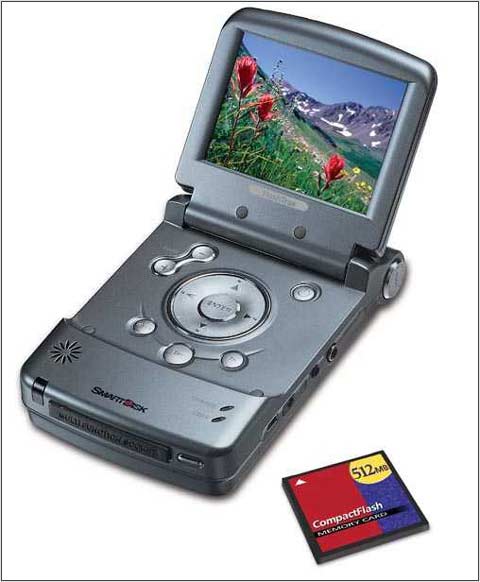I took this photo towards the beginning of my recent trip to Yosemite, Owens Valley, and the desert. It’s pretty similar to another image that I blogged at the beginning of my series of stories about this trip.
So here’s the thing. I was photographing for about a week and generated thousands of images. By the very nature of the thing, most of these images are discards. But many are not. I certainly can’t tell from the LCD display on my Nikon D70 whether or not I’ve hit the jackpot.
It’s not the point of this story, but the way I work, I don’t always know when I have a good image until second (or subsequent) passes through my files — as is the case with this Yosemite autumn image, which was not my first choice in its set. (You can decide for yourself which you prefer!)
A 1 gigabyte CF (compact flash) memory card stores something like 140 images for me in Camera RAW plus JPEG. A possible strategy for me would be load up on ten or fifteen of these cards. Drawbacks: somewhat expensive and still limited in the amount of storage (to the ten or fifteen gigabyte maximum). Also worth noting, these cards are magnetic medium and potentially fragile. Photographers in the field should protect them from sand, moisture, and not drop them.
I think I’ve come up with a better alternative. I use a little device called the FlashTrax with a 40 Gigabyte hard drive and a viewing screen from a company called SmartDisk. Here’s a picture:

The FlashTrax thing costs about $400 in the 40 Gigabyte model, so it is not cheap. It does have a hard drive in it, so you should protect it from unnecessary bumps and bangs. However, my experience is that the thing is quite sturdy. It’s survived a nasty backpacking trip, river crossings, sandstorms in the desert, and more.
The thing holds its charge a pretty long time, and you can also recharge it from a car lighter.
My process is pretty simple. I have two memory cards. When my first one gets filled, I slam it in the FlashTrax and press the copy button. By the time I’ve filled up the second memory card, the pictures on the first have been copied to the FlashTrax. I make a point of reformatting the flash memory card in my camera, not in the FlashTrax. When I get home, I use a USB connection to get the images off the FlashTrax and onto my computer.
I can conceive of a situation in which the FlashTrax would not provide enough field storage–three months in Antarctica, for example, with no access to the Internet. But for most purposes, it will do the trick.
In my research, the FlashTrax was the device that had been designed with photographers most in mind–the quick copy from a memory card is great, for example. But the FlashTrax is a multipurpose device, it plays movies and music and more. You can also use other media players, such as the Apple iPod, as a digital storage repository–and an iPod is probably a pretty good choice for this purpose. If you decide to use your iPod to store digital pictures from your camera, you need to buy the (inexpensive) iPod Camera Connector accessory for this purpose.

rpeters
27 Aug 2007Harold,
Actually, except for the MicroDrive type of CF cards, CF Flash memory is based on the floating-gate transistor and are not magnetic. The bit is stored as a small charge (excess of electrons) in a region of the transistor that is surrounded by an insulator.
You can get more details at:
http://en.wikipedia.org/wiki/Flash_memory
I love your site!!!!
Regards,
Ron Peters